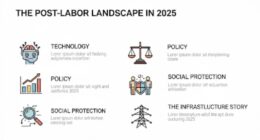The demand paradox suggests that economies struggle to thrive when workers have no wages, as consumer spending relies heavily on income. Without wages, demand drops, slowing growth and causing instability. While automation and alternative demand mechanisms like government support help, they may not fully replace the purchasing power of wages. To understand how economies can navigate this challenge and find sustainable paths forward, explore the options and strategies that are shaping the future.
Key Takeaways
- Without wages, consumer demand drops, risking economic contraction unless alternative demand mechanisms are in place.
- Automation and social programs can sustain demand when wages are absent, but may not fully replace traditional income-driven spending.
- Wages drive consumer confidence and spending, essential for growth; their absence challenges traditional growth models.
- Non-wage demand sources like government support and community initiatives can help maintain economic activity.
- Relying solely on capital income and automation may lead to inequality and limit broad-based economic thriving.
Understanding the Demand Paradox in Modern Economies

Understanding the demand paradox in modern economies is essential because it reveals how economic variables can behave counterintuitively, often defying traditional theories. You might expect that if people save more, overall demand drops, but sometimes increased savings can reduce economic activity—this is known as the paradox of thrift. Similarly, technological improvements intended to boost efficiency can lead to greater resource consumption through the Jevons paradox. These paradoxes showcase the complex interactions within economic systems, where actions like increasing demand or saving can produce unexpected results. Recognizing these patterns helps you grasp why economic variables don’t always follow straightforward logic. Studying these paradoxes is crucial for developing policies that promote stability and avoid unintended consequences in a constantly evolving economic landscape. Additionally, understanding the role of demand in these scenarios highlights how shifts in consumer behavior can influence overall economic health in unpredictable ways, especially when considering economic interactions that may seem straightforward but have complex ripple effects. For example, changes in market behavior can amplify or dampen these paradoxical outcomes, emphasizing the importance of nuanced analysis. A deeper appreciation of these counterintuitive outcomes can inform better decision-making at both policy and individual levels. This awareness fosters curiosity about the underlying mechanisms driving these phenomena, enabling more effective responses to economic challenges.
The Role of Wages in Driving Consumer Spending

Wages directly influence how much you and others spend, fueling demand in the economy. When wages rise, consumer confidence boosts, leading to increased spending; without wages, demand often stalls. Understanding this relationship helps clarify whether economies can truly thrive without wage growth. Additionally, payment frequency plays a crucial role in shaping perceptions of wealth and spending behavior, even when actual income remains unchanged.
Wages as Demand Fuel
When wages rise, consumer spending typically follows suit, since higher disposable income empowers you to buy more goods and services. In 2023, average expenditures increased by 5.9%, reaching $77,280, showing how wage growth boosts spending. Your median annual earnings of $58,140 give you extra flexibility to spend or save. The frequency of your payments also matters; daily payments can increase your annual spending by about $260 compared to monthly paychecks. When wages go up, household spending often increases, fueling economic growth. This effect is evident in the impact of minimum wage hikes, which can raise overall demand and stimulate the economy. Wages act as a direct driver of demand, making consumer spending a key component of economic crucial.
Impact of Wage Absence
Without wages providing a steady stream of income, consumer spending can drop sharply, directly impacting the economy. When wages vanish or decline, your confidence and ability to spend decrease, slowing economic activity. Households may rely on savings or debt, risking financial instability. Governments can help with support programs like unemployment benefits and stimulus payments, but these often only partially replace lost wages. The table below shows how wage absence and support impact spending: Wage stagnation directly diminishes consumer demand, which is a key driver of economic growth. | Wage Absence Effect | Response/Support | |———————|—————————————–| | Reduced consumer confidence | Government stimulus helps temporarily | | Decreased household income | Reliance on savings or debt | | Lower overall spending | Support programs can mitigate effects | | Financial instability | Sustained government aid improves stability
Technological Advances and the Shift Towards Automation

Technological advances are reducing our dependence on wages by automating routine tasks and boosting efficiency. As automation improves productivity, demand can increase even when wages stagnate or fall. This shift challenges traditional economic models that rely heavily on consumer spending driven by wage growth. Furthermore,, widespread automation could lead to significant economic disruption, potentially affecting global GDP and employment patterns. Additionally, the labor market may face structural changes as jobs become obsolete, necessitating new approaches to employment and income distribution. Moreover, integrating predictive analytics for small business can help identify emerging opportunities and mitigate risks associated with these economic shifts. Understanding these shifts requires a focus on developing adaptable economic policies and fostering skills that complement automation.
Automation Reduces Wage Dependence
Advances in automation have reshaped the labor market by reducing workers’ dependence on wages. Since the 1980s, automation has displaced routine tasks, causing wage declines for lower-skilled workers and shifting profits from labor to owners. While productivity has soared, labor demand has decreased, intensifying economic inequality. Automation creates new jobs, mainly in high-skilled sectors, but often leaves low-skilled roles, like personal services, paying less. For every robot added per 1,000 workers, wages drop by 0.42%, and employment ratios decline. Automation also amplifies wage gaps, favoring high-skilled workers and increasing market polarization. As technology advances, workers must adapt through education and training, but the overall trend reduces the reliance on wages, transforming how economies function and how wealth is distributed.
Efficiency Sparks Increased Demand
As automation reshapes workplaces, it also drives efficiency by boosting productivity and transforming how goods and services are produced. This increase in efficiency can lead to heightened demand in several ways:
- Increased productivity elevates overall output, making goods more accessible and affordable.
- Digitalization enhances market transparency, encouraging more transactions and expanding markets.
- Automation reduces human labor costs, freeing resources for reinvestment in innovation and consumption.
- Technological advances raise GDP per worker, creating a more efficient economy capable of supporting higher demand levels.
- The adoption of comfort solutions like ergonomic equipment can further boost worker satisfaction and productivity in automated environments.
Alternative Mechanisms for Sustaining Demand Without Wages

When traditional wage-based demand declines, alternative mechanisms step in to sustain economic activity and community well-being. Food stamps boost purchasing power for low-income households, helping maintain demand for essentials. Governments provide subsidies and grants to support key industries and services, ensuring continued consumption. Free or low-cost public services like healthcare and education meet basic needs without relying on wages, keeping demand steady. Community cooperatives, owned and operated by members, offer goods at lower prices, fostering local economic activity. Additionally, government intervention through fiscal policies and stimulus packages can stimulate demand during downturns. Special events and themed breakfasts create community cohesion and support local economies, further contributing to demand stability. These mechanisms create resilient support systems, ensuring communities stay active and economies continue functioning, even when traditional wage-driven demand weakens. Recognizing the importance of economic resilience helps communities adapt to changing circumstances and maintain stability in challenging times. Moreover, implementing merchant services that facilitate alternative payment options can help sustain transactions even in periods of financial constraint. Understanding the role of informal economies can also provide additional avenues for maintaining demand in underserved sectors. Additionally, promoting consumer confidence can encourage spending despite economic uncertainties, reinforcing demand stability.
The Impact of Zero-Wage Economies on Economic Growth

Zero-wage economies challenge traditional growth models by relying less on consumer spending driven by income and more on alternative demand sources. Without wages, overall demand drops because workers lack purchasing power, slowing GDP growth. You might see:
Zero-wage economies weaken growth by reducing consumer demand and shifting reliance onto unstable income sources.
- Reduced consumer demand, limiting business revenue and investment.
- Increased capital income, but only benefiting capital owners without broad economic expansion.
- Diminished multiplier effects, making it harder for investments to generate growth.
- Shifts toward non-labor income sources, which often worsen inequality and restrict broad-based growth.
- The absence of collaborative innovation in such environments hampers the development of new solutions and economic resilience. Additionally, the lack of wage-based demand can hinder the development of local economies by reducing the flow of money within communities, further impacting growth prospects. Furthermore, the absence of wages may decrease consumer confidence, leading to a cycle of reduced spending and economic stagnation. While capital accumulation may rise, it doesn’t guarantee increased productivity or demand. This environment risks stagnation unless new demand mechanisms emerge, and the economy’s ability to grow sustainably becomes uncertain.
Policy Strategies to Support Economies Lacking Traditional Wages

To support economies that lack traditional wages, policymakers can implement targeted strategies that stimulate demand and promote sustainable growth. Monetary policies that keep interest rates low encourage hiring and wage increases. Increasing public investments in infrastructure, education, and R&D creates jobs and boosts economic activity. Modernizing labor standards—restoring real minimum wages and overtime thresholds—improves wages for low-income workers. Strengthening collective bargaining enhances workers’ bargaining power, leading to better wages. Improving wage transparency allows workers to negotiate effectively. Additionally, targeted employment programs in high-unemployment areas can generate jobs and raise wages. Aligning education with in-demand skills increases early-career wages. Ending subminimum wages and providing financial incentives like Pell Grants support mobility and career growth, further strengthening economic resilience. Recognizing the importance of Best Beaches as vital economic drivers, especially through tourism, can also bolster local economies. Incorporating software quality assurance best practices into economic policy planning can ensure effective implementation and ongoing improvement of these strategies. Moreover, exploring innovative Unique and Wicked Planters solutions can inspire sustainable and engaging community development projects. Understanding regional divorce statistics and legal resources can also inform policies that support workforce stability and economic participation. Additionally, integrating a comprehensive understanding of aura and emotional well-being can foster more holistic approaches to workforce development and community health initiatives.
Resource Efficiency and the Risks of the Rebound Effect

Resource efficiency aims to reduce the amount of resources needed for various activities, but it can also lead to unintended consequences known as the rebound effect. When efficiency improves, costs drop, prompting increased consumption that offsets savings. For example:
Efficiency gains can unintentionally boost resource use and undermine sustainability efforts.
- Energy use: Cheaper energy often results in more frequent or longer use.
- Water and labor: Gains in efficiency can lead to higher demand for resources like water and labor.
- Market responses: Lower prices boost demand, influencing overall consumption patterns.
- Environmental impact: Increased demand from efficiency gains can worsen environmental degradation and challenge sustainability efforts. Recognizing these dynamics is vital for designing policies that genuinely reduce resource consumption.
Additionally, the rebound effect can be amplified when resource management strategies focus solely on efficiency improvements without addressing consumption behaviors, further diminishing the expected environmental benefits. An understanding of behavioral change is crucial for developing comprehensive approaches that curtail excessive resource use rather than merely improving efficiency. Moreover, increasing awareness of consumer habits can help mitigate some of these rebound effects by encouraging more sustainable consumption patterns.
Rethinking Value and Compensation in a Wage-Less Future

As economies seek sustainable ways to grow without relying solely on traditional wages, rethinking how value is created and compensated becomes necessary. You can explore productivity pay mechanisms that link pay directly to output, performance, and efficiency, incentivizing innovation. Incentive plans align worker interests with organizational goals, boosting productivity. Alternative pay systems, like quasi-fixed proportions or fund shares, offer flexible, performance-based models that adapt to new economic realities. In healthcare, value-based care and risk-sharing models focus on outcomes rather than hours worked. These approaches balance productivity and nonproductivity elements, fostering innovation and efficiency. Technological advances simplify pay distribution, while social acceptance and risk management assure stability. By reimagining compensation, you can create systems that motivate contributions beyond wages and support sustainable economic growth.
Navigating Uncertainties and Preparing for Economic Paradigm Shifts

Navigating economic uncertainties requires proactive strategies to adapt to shifting conditions and emerging paradigms. You need to understand how global trends impact your sector and prepare accordingly. Consider these key steps:
- Monitor regional growth patterns, focusing on emerging markets like India and Latin America, which offer investment opportunities despite slowdown risks elsewhere.
- Adjust your strategies for policy changes, such as rising tariffs and interest rates, to mitigate their effects on costs and trade flows.
- Stay alert to technological and social shifts, like the rise of Emotional Intelligence, which could redefine business priorities.
- Incorporate scenario planning to anticipate economic paradigm shifts, such as localization trends and declining oil demand, preparing your organization for rapid change.
Frequently Asked Questions
How Would Consumer Demand Be Sustained Without Wages?
Without wages, consumer demand would struggle to stay steady because people rely on income to buy goods and services. You might see demand maintained temporarily through savings, government support, or borrowing, but long-term sustainability is unlikely. To keep demand alive, you’d need alternative income sources, like social programs or investments, but ultimately, wages are essential for consistent consumer spending and economic growth.
Can Technological Progress Fully Replace Wage-Based Income?
Imagine a robot chef in your favorite restaurant, capable of preparing countless dishes. While it can replace routine cooking tasks, it can’t replicate the creativity, judgment, and adaptability of a human chef. Similarly, technological progress can’t fully replace wage-based income because human labor involves complex skills, emotions, and decision-making. Technology can augment work but falls short of completely replacing the diverse, nuanced roles humans play in the economy.
What Alternative Demand Sources Could Support Zero-Wage Economies?
You might wonder what keeps an economy moving without traditional wages. You can look at state-supported demand, like public investments, social welfare, and public employment programs, which boost spending. Technological advances, automation, and digital platforms create new value streams. Additionally, globalization, trade, and alternative models like cooperatives and barter systems provide demand sources. These mechanisms help sustain economic activity, even when wages aren’t the primary driver of consumption.
How Might Zero-Wage Systems Impact Income Inequality?
Sure, imagine a world where wages vanish—what could go wrong? You’d see income inequality skyrocket, as the rich hoard resources and the poor struggle to survive. Without wages, your purchasing power drops, widening the gap and fueling social unrest. Governments would scramble for solutions like UBI, but unless fair distribution follows, economic disparity would deepen, making equality just a distant dream in this wage-less fantasy.
Are There Historical Examples of Successful Wage-Less Economic Models?
You wonder if there are successful wage-less economic models in history. While many experiments like Goulash Communism and Yugoslav self-management aimed to reduce or eliminate wages, they often faced significant challenges, including resource allocation and inequality. Some, like China’s blend of market socialism, showed partial success but still relied on wage-like mechanisms. Overall, truly successful, long-term wage-less systems remain rare and face substantial practical hurdles.
Conclusion
Just like a boat needs a steady sail to stay afloat, an economy relies on demand to thrive. Even in a world where wages vanish, you can explore new ways to keep demand alive—through technology, resource efficiency, or innovative policies. Embrace the challenge as an opportunity to rethink value and growth. With adaptability and vision, you can navigate the shifting currents of a wage-less future and steer your economy toward resilience.









